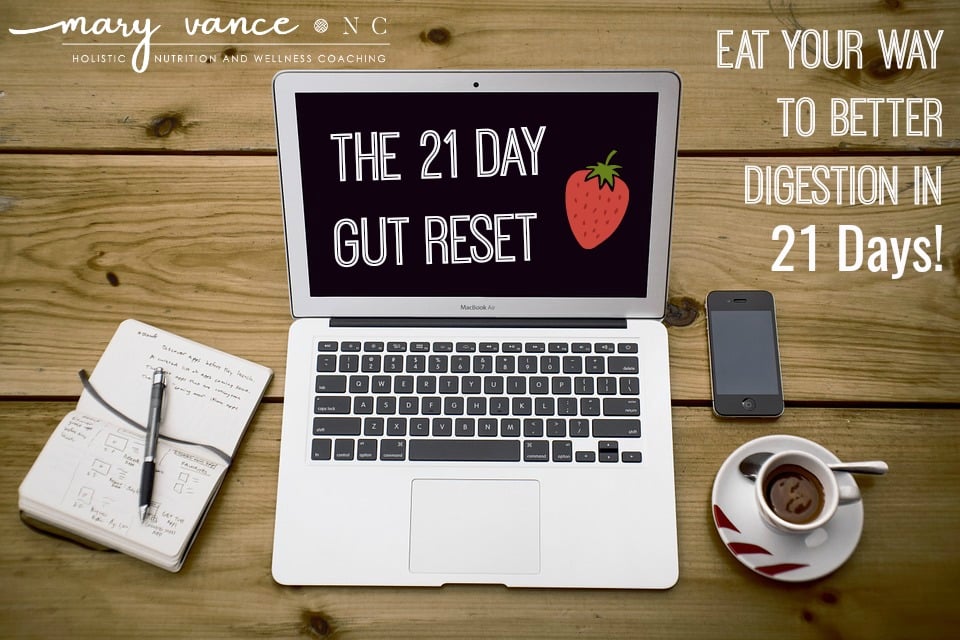If recent blood work has shown your fasting blood sugar (glucose) levels are elevated or above optimal, it’s time to take action before the issue escalates into diabetes or pre-diabetes. Is your fasting blood sugar above 95 mg/dL? Most of us are aware that uncontrolled high blood sugar leads to type 2 diabetes, but it also contributes to weight gain, metabolic syndrome, heart disease, increased oxidation (read: accelerated aging), inflammation, and high blood pressure. ALL of these conditions are preventable via diet and lifestyle changes. Even if you have a family history of diabetes, you are not a slave to your genes. You can lower blood sugar levels naturally to prevent disease and look and feel better.
If you are an American age 40 to 70, the odds are about 40 percent that you’ve been diagnosed with diabetes or pre-diabetes. (source) That means nearly HALF of us aged 40-70 have blood sugar regulation issues, likely from consuming too much sugar and too many refined carbs.
What is High Blood Sugar?
Also called hyperglycemia or high blood glucose, high blood sugar means there is too much glucose circulating in your bloodstream because your cells have shut the door and will not receive any more glucose. Frequent or ongoing high blood sugar levels damage your nerves, blood vessels, and organs.
Fasting high blood sugar is considered higher than 130 mg/dL after 8 hours of fasting, and postprandial (after a meal) high blood sugar is higher than 180 mg/dL two hours after you eat. Your blood glucose shouldn’t rise over 140 mg/dL after meals.
Normal fasting blood glucose is between 75-95 mg/dL. Although 100 is often considered the cutoff for normal, studies have shown that fasting blood sugar levels in the mid-90s were predictive of future diabetes a decade later. Ideal fasting blood glucose is 85 mg/dL.
Post-prandial blood sugar is just as important and should be 100-120 mg/dL two hours after you eat.
What Causes High Blood Sugar?
When you eat sugar or carbohydrates, the pancreas responds by secreting the hormone insulin to move excess glucose from the blood into the cells where glucose is used to produce energy. This is a normal and healthy response. If you eat too much sugar and/or too many carbs (especially refined carbs that break down quickly into sugars), your pancreas must secrete more and more insulin to usher glucose into the cells to prevent dangerously high blood sugar levels. But your cells don’t need any more glucose and lose the ability to respond to insulin. The cells shut the door; no more glucose allowed. The pancreas responds by pumping out even more insulin in an effort to get glucose into the cells, and this eventually causes insulin resistance.
Over time, insulin resistance can lead to type 2 diabetes and prediabetes because the pancreas cannot keep up with the body’s increased need for insulin. Without enough insulin, excess glucose builds up in the bloodstream, leading to diabetes, prediabetes, and other serious health issues. Blood sugar levels continue to rise until the person is called diabetic.
Excess blood sugar also makes you fat. Insulin is a fat storage hormone. If the cells don’t need any more glucose, the remaining is converted to fatty acids, and insulin stores this excess as fat, typically in the stomach, hips, butt, boobs.
High insulin levels also contribute to hardening of the arteries and high blood pressure, making the person more susceptible to heart disease. The deadly trio of belly fat, high blood pressure, and high blood sugar is known as “metabolic syndrome,” and is a warning sign that you are at high risk for diabetes or heart disease.
How Do I Know if I Have High Blood Sugar?
The main symptoms of high blood sugar are increased thirst and frequent urination. The first step is to request a fasting blood draw to check fasting glucose and A1C levels. As mentioned above, ideal fasting blood glucose is 85 mg/dL, but under 100 is considered OK. Levels greater than 126 mg/dL are diagnostic for diabetes. An A1C under 5.7 percent is considered normal. An A1C between 5.7 and 6.4 percent is diagnostic for prediabetes, and an A1C equal to or above 6.5 percent is diagnostic for diabetes.
I often recommend purchasing an inexpensive glucometer so you can check blood sugar at home first thing in the AM and after meals.
How to Lower Your Blood Sugar Naturally: Diet
The easiest and fastest way to lower your blood sugar is to stop eating sugar (white, brown, raw, turbinado–all of it), refined carbohydrates, and refined starches. That means eliminating candy, baked goods, soda, white bread, pasta, fruit juice, corn starch, potato starch. This also eliminates most of the high glycemic index foods that have a big impact on blood sugar: bagels, white bread, sodas, Idaho potatoes, cereal. Click here for help overcoming sugar cravings.
Those with high blood sugar, diabetes, and pre-diabetics respond very well to a lower carbohydrate diet with moderate to high levels of good fats and proteins. How much carb you need depends on your physiology and activity levels. Good carbs to focus on include vegetables of all types, especially the green leafy and crunchy veggies.
1) I recommend avoiding most, if not all, grains until your blood sugar falls into normal range. Focus on a paleo type plan with plenty of veggies for the majority of your meals, with appropriate amounts of protein and healthy fats such as olive oil, butter/ghee, and coconut oil. Absolutely NO vegetable oils or hydrogenated oils that contribute to inflammation. That said, legumes (beans, lentils), which are typically eliminated on a paleo diet, have amazing benefits for lowering blood sugar for most people, and they’re a great source of fiber.
There is also evidence that a ketogenic diet can improve glycemic levels in those with type 2 diabetes and prediabetes. (source)
2) Increase minerals that help regulate blood sugar: especially chromium, vanadium, magnesium, zinc. Green vegetables such as chard, spinach, kale, and collards are high in minerals. Sea vegetables are excellent sources of trace minerals. (Pro tip: Try Sea Snax as a snack). Use real sea salt and sip on mineral-rich bone broths.
3) Make about half your plate veggies of all kinds, mostly the green leafys like kale and chard and the crunchies like broccoli and cauliflower. Use the starchy root veggies such as potatoes (sweet, red, purple, NOT Idaho) sparingly. Add about a palm size of organic protein such as egg, beef, lamb, poultry, wild seafood. Add avocado and/or olive oil, coconut oil, butter/ghee. Eat fruit, but don’t over do it: 2 pieces per day max, and stick to the lower glycemic berries, which offer wonderful antioxidant support.
If you get a sugar craving, small amounts of 70 percent or higher dark chocolate are acceptable.
Foods that lower blood sugar include the following:
- Cinnamon has proven blood sugar reducing properties. Add a teaspoon to smoothies, or many of the blood sugar lowering supplements I recommend include it as an ingredient.
- Avocados and nuts such as almonds, walnuts, Brazil nuts
- Blueberries
- Prickly pear cactus pads known as Nopales cactus contain a substance that is remarkably close to the drug Metformin, and can be very useful for lowering blood sugar regulation. Try them grilled with olive oil. They’re delicious and not hard to find.
- Apple cider vinegar: try 1 tsp in a little water daily. It increases insulin sensitivity and reduces blood sugar spikes after eating starchy food.
- Legumes
- Sea vegetables and super greens like spirulina
- Leafy greens: kale, chard, spinach, dandelion greens, collards, mixed salad greens
How to Lower Your Blood Sugar Naturally: Supplement Protocol
ALWAYS check with your doctor before taking any herbs or supplements, because they have powerful blood sugar lowering effects that can cause blood sugar to drop too low if you’re on prescription drugs such as Metformin. One bonus to note is that I’ve had clients following my recommended diet and this protocol drop their prescriptions completely!
Look for supplements with the following: alpha lipoic acid, chromium, zinc, magnesium, cinnamon, fenugreek, gymnema, berberines. Most of the supplements recommended below contain these nutrients and herbs in balanced formulas.
- My favorite blood sugar balancing supplement combines chromium with other trace minerals and cinnamon to help stabilize blood sugar levels. Bonus: it reduces sugar cravings!
- Berberine is a compound found in the roots, rhizomes, stems and bark of several plants, and it has amazing blood sugar lowering properties. Try this supplement that combines berberines with alpha lipoic acid as well. It’s beneficial for diabetes, pre-diabetes, insulin resistance, elevated triglycerides.
- Take a fish oil to reduce inflammation.
- This multi is specially formulated to support healthy blood sugar and insulin levels.
- I recommend this magnesium.
How to Lower Your Blood Sugar Naturally: Lifestyle Adjustments
The holistic model means addressing all aspects of one’s life: diet, stress, exercise, lifestyle, emotional wellbeing. There are several modifications you can make to support healthy blood sugar.
- Maintain healthy cortisol levels by addressing your stress levels. We all have stressful lives, but addressing stress and incorporating relaxation into your routine makes a world of difference in maintaining healthy stress hormone levels. High stress = high cortisol = high blood sugar and inflammation. Attention to adrenal support may be necessary. Cortisol is a primary hormone involved in blood sugar regulation, and if it’s too high or too low, you won’t have efficient blood sugar control.
- SLEEP at least 8 hours. Lack of sleep drives up cortisol levels because your body perceives it as a stress.
- Eat in regular intervals for healthy blood sugar levels. Skipping meals or eating irregularly causes cortisol fluctuations and blood sugar swings.
- EXERCISE! Get moving. Exercise alone is one of the most effective ways to lower insulin levels. You’ll feel better, relieve stress, and look better, too.
- Consider purchasing an inexpensive glucometer so you can track your progress by measuring your blood glucose levels first thing in the AM and after meals.

Mary Vance is a Certified Nutrition Consultant and author specializing in digestive health. She combines a science-based approach with natural therapies to rebalance the body. In addition to her 1:1 coaching, she offers courses to help you heal your gut and improve your health. Mary lives in San Francisco and Lake Tahoe in Northern California. Read more about her coaching practice here and her background here.








Thank you for these tips. I don’t want to exhaust my liver and kidney with the medicine I take for lowering my blood sugar. I already exercise and avoid sweet food. I hope this list will help me get better.